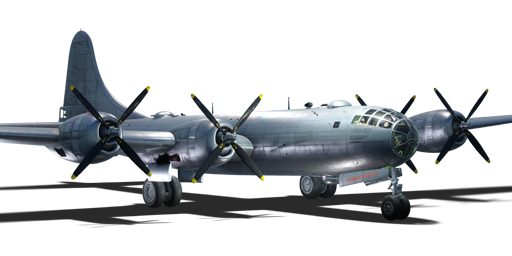



In the few years leading up to World War II, the United States Army Air Corps (USAAC) realized that its current primary heavy bomber, the B-17 would not have the range nor the payload to efficiently transit what would end up becoming the Pacific Theater. To compensate for this, Boeing began to develop a prototype which would incorporate a pressurized cabin to allow for higher altitude flying, which would help to protect the bomber from Japanese fighters which struggled to get to the higher altitudes.
The resulting XB-29 prototype and the later production series B-29 bomber had everything the USAAC was looking for: high-pressured cockpit, a maximum altitude of almost 9,750 m (32,000 ft), true airspeed around 600 km/h (372 mph), and the ability to carry a massive payload of bombs upwards of 9,000 kg (20,000 lbs) in total. Defensive positions on the B-29 were well-placed to ensure maximum coverage surrounding the bomber. This bomber was one of the first aircraft to be fitted with the General Electric Central Fire Control system which could be used to remotely control four of the remotely controlled turrets (two dorsal and two ventral), though in their early stages, this aircraft's turrets each also had a General Electric analogue computer linked to it allowing the weapons to be more accurate by automatically factoring in airspeed, gravity, temperature, and lead time for the inbound aircraft. With this setup, these turrets could be controlled from the nose, tail or any of the three mid-fuselage positions and a single gunner could actually control more than one turret at a time increasing the effectiveness and lethality of the bomber's defences. Bristling with 12 x M2 Browning machine guns, the B-29A-BN was extremely difficult to approach, let alone make a successful pass and leave untouched.
The B-29A-BN was introduced in Update 1.47 "Big Guns". Unlike other bombers which can take on a secondary role as a pseudo-attacker, the B-29A-BN is a bomber, period. The sole purpose of the B-29 is to beat ground targets into submission either with upwards of 40 x 500 lb bombs, 18 x 1,000 lb bombs, 8 x 2,000 lb bombs or 4 x 4,000 lb bombs. The larger 1,000, 2,000 and 4000 lb bombs are perfect for base bombing while the relatively smaller 500 lb bombs make the perfect tool for carpet bombing where vehicles, pillboxes or anti-aircraft artillery may be clustered together. The B-29A-BN is an aerial beast which can drop a beastly amount of explosive ordnance, rivalled by few, but is not immune to enemy fighters. Altitude is this bomber's friend and when achieved can be a safer haven from which to rain down explosives on enemy bases or vehicles. Any opponents that persist in attempting to intercept the B-29 can be easily taken care of by the large complement of defensive .50 cal machine guns, with excellent rate of fire, ammunition capacity, and coverage.
flaps
flaps
flaps
brake
| Belt | Belt filling | Armor penetration (mm) at a distance: | |||||
|---|---|---|---|---|---|---|---|
| 10 m | 100 m | 500 m | 1000 m | 1500 m | 2000 m | ||
| API-T/AP/AP/I | 30 | 27 | 20 | 13 | 9 | 6 | |
| AP/AP/AP/API-T | 30 | 27 | 20 | 13 | 9 | 6 | |
| AP-I/I/AP-I/API-T | 28 | 26 | 18 | 11 | 7 | 4 | |
| Belt | Belt filling | Armor penetration (mm) at a distance: | |||||
|---|---|---|---|---|---|---|---|
| 10 m | 100 m | 500 m | 1000 m | 1500 m | 2000 m | ||
| API-T/AP/AP/I | 30 | 27 | 20 | 13 | 9 | 6 | |
| AP/AP/AP/API-T | 30 | 27 | 20 | 13 | 9 | 6 | |
| AP-I/I/AP-I/API-T | 28 | 26 | 18 | 11 | 7 | 4 | |












Flight performance | |
|---|---|
Survivability |
|---|
Weaponry | ||
|---|---|---|